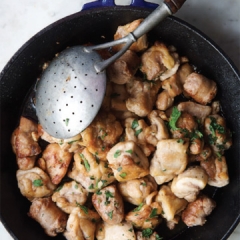A Cook's Best Friend In The Kitchen
The lists of gadgets and cookware on wedding registries is astounding — do people really need all of that stuff? Not really. Being a good cook doesn't mean owning fancy equipment or having a kitchen full of shiny pots and pans. For a new couple or new cooks, there are only a few basic tools one needs to succeed in the kitchen, and one of those is a cast-iron skillet.
"I've got a skillet and Dutch oven that were wedding presents for my grandmother in 1918," says Mark Kelly of Lodge, the five-generation family-run business known for its cast-iron products. Kelly's point is to emphasize the durability of these kitchen tools. While owning the entire Williams-Sonoma catalogue is fun, when it comes to the basics of cookware, there really isn't anything better than a cast-iron skillet.
Why? It's both oven- and stovetop-safe, meaning it can be used for anything from frittatas to roasts and most things in between. Yet, there seems to be an intimidation factor when it comes to purchasing and using cast-iron products. "Isn't the seasoning difficult?" "Aren't they hard to clean?" The answers to both questions are quite simply, no. Not at all.
We posed these questions and more to Mark Kelly to help demystify cast iron, plus included a few recipes from The Lodge Cast Iron Cookbook that's filled with favorite recipes from cookbook authors, chefs, food writers, and more who swear by their cast-iron products.
Maybe it's time to rethink that wedding registry...
 Maintaining and Re-Seasoning Cast Iron
Maintaining and Re-Seasoning Cast Iron
Lodge cast-iron products come seasoned, so the main goal, as Kelly says, is to maintain the seasoning. He recommends that when you purchase it, put a little olive oil all over it before you cook. Then, after cooking and cleaning, rub a little olive oil on it and place it on the stovetop or the oven for five minutes so that the oil seeps in. Basically, he explains that the black patina should always be very rich and a little shiny. If there's any rust showing, rub it off and put some oil on it.
Click here to see 5 Myths About Cast Irons.
It's a super conductor of heat, but it also retains heat and evenly distributes it so that it resists burning or scorching — a coveted feature when searing meats. As Kelly says, a lot of skillets on the market aren't ovensafe and with the cast-iron one you can "virtually do any cooking technique, sauté, bake, stir-fry, and put it under the broiler. It's a hall of fame product." It's also relatively inexpensive compared to other cookware, and if it's taken care of like he recommends, then it can "virtually last forever." Plus, the more you use it, the better it will be.
Click here to see the Chicken Scarpariello recipe pictured at left.
 Versatility of the Product: From Pancakes to Steaks
Versatility of the Product: From Pancakes to Steaks
Lodge offers a variety of cast-iron products, like the skillet, Dutch oven, griddle, and reversible griddle, that can be used to cook almost anything — which is something some people do. Kelly explains that the heat retention makes the surface ideal for baking and "probably the best thing in the world for searing steaks." He even places his skillet on the grill to sear steaks because it gets the smoky flavor and the good sear.
It's also useful for stir-frying vegetables, like in the fajita recipe pictured at left, because the vegetables get a crisp browning. Similarly, the griddle can be used for pancakes and the grill side for marking up steaks and other proteins.
"People are afraid of getting it too hot, but it can take the heat," says Kelly. When baking in the oven, it's best to heat the cast-iron product in the oven as well so it reaches the same temperature as the oven. But, he explains that for cooking eggs or bacon, it doesn't have to be as hot as when frying chicken. (The added benefit of cast iron is that because it retains heat so well, it takes less time to cook foods.) Click here to see the Breakfast Frittata recipe pictured at left.
Cleaning
Kelly recommends letting the pan cool off a little before cleaning because putting cold water on it when it's really hot may cause it to crack. When washing, he says to use warm water and a nylon brush to clean off any particles — if it needs more than that, use a nylon scraper. Then, follow his instructions above on maintaining the seasoning.
Click here to see the Chicken with Artichoke Hearts, Olives, and Capers recipe.
Follow @yasminfahr on twitter.

